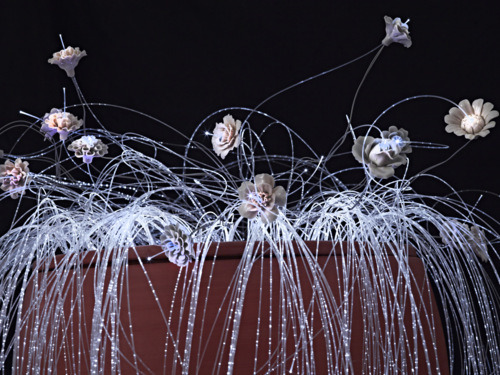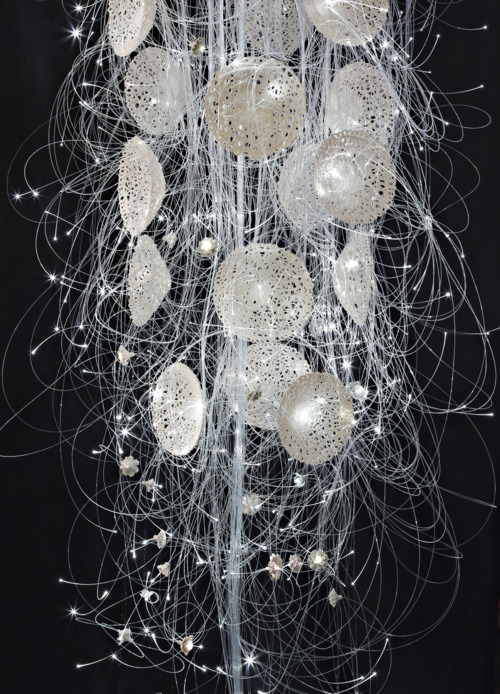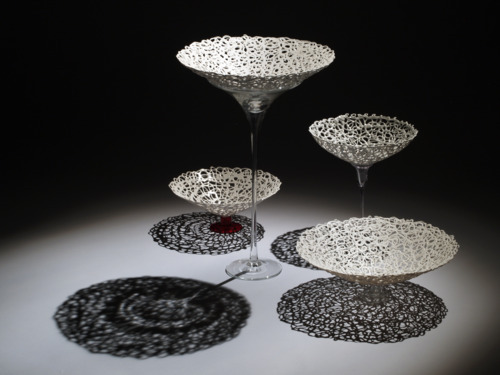
You are a very consequent artist, having worked with ceramics all your career. Why did you embark on this journey?
I was born in Faenza; I studied in Faenza at the “Ballardini” Art Institute, and I have been teaching at this same school for over 30 years. It has just been so natural to work with this material in this city because it’s so well-known throughout the world for its ceramics.
The techniques and subjects you are approaching are very different – paper clay, fibre optic installations and low temperature. Working with so many different materials may be difficult, how do you manage to combine them?
Well, I come from Italy, a country where the artists feel the weight of our history and ceramic traditions, but where there are also many new influences from the world of design and fashion!
In fact, in the last few years, in the design and fashion sectors there has been a notable trend regarding lightness and attention to detail, which is so incredibly in line with my way of being and working.
I believe that the greatest undertaking of the artist is that of professional maintenance. As a matter of fact, along with spontaneous creativity, you indissolubly must add an elevated professional competence regarding technique; through reading and observation, the joy of experimentation, of combining, and of moving forward.
Your attention to detail makes your paper clay works unique and pure within their shadows. Tell us about the constructing process.
I’ll tell you how you can, while having an idea in mind, transform and tame my technique. My way of working is not traditional. My objective is to create lightness in ceramics- not only regarding weight but also visually. I need to discover the right combination of materials in order to obtain the results you see.
I have tried different types of syringes, of clays, and supporting moulds. For example, my experiments with plaster moulds weren’t suitable because the objects made in paper clay were impossible to remove without destroying them.
Instead of creating holes by cutting out shapes, my pieces have been formed using a very thin decoration that creates their form: it’s an art of addition, not of subtraction.
The use of shadows has always been important in my work.
As with the “Butterflies/Farfalle”, there is a special effect using light and shadow. The butterflies are created using one real wing and the other virtual. The idea is to minimize the use of ceramic material, with the use of light to complete the work.

When did you start working with fibre optic installations?
I started in 2008.
The installations – with their porcelain elements, are oriented towards the design of an ambient sculpture focusing on the creation of light through the use of fiber optic technology.
Ethereal lights, characterized by a floating lightness and luminosity, cross the boundaries between the art, fashion and design of the piece.
The light plays and creates new forms inserting themselves into the ceramic, wrapped by light, it loses its materiality and sense of gravity and regains the flexibility and dynamics of the forms.
The emptiness is given life and from obscurity emerges a thick network of optical illusions.
There are many influences that, put-together, help you deliver the sense of uniqueness of your works. What motivates you?
My design is born from a rereading of past artistic production through a filter of formal personal sensibility directed towards the making of a functional or sculptural object. The forms generated are aesthetically accurate and display a strong sense of real feminine character, of grace, elegance and attention to detail.
Thus, “Crespines”, objects originally of Faentinian tradition that were used in the Grand European Courts of the 16th and 17th centuries, have been remade in porcelain paper clay for a new collection which began in 2005.
And it was for this collection that experimentation with porcelain paper clay was indispensable
It was challenging and exciting to create forms derivative of the past, but reconsidered with completely new techniques and philosophies.
You have just come back from Korea, where you participated at the Cheongju International Craft Biennale and The Gyeonggi International Ceramix Biennale 2011 in Icheon. How would you describe the atmosphere?
My experience in Korea was very interesting. At the Cheongju Craft Biennale, where I received an Honorable mention, I was able to see the international scene of applied arts. While at the Gyeonggi International Ceramix Biennale 2011 in Icheon, the exhibition of the competition showed us a panorama of extremely high level ceramics, particularly in relation to the contemporaneous use of mixed media and to the more conceptual aspects of the pieces. The atmosphere of the workshop in which I participated was also very stimulating: 20 Korean artists and 20 international ones were able to compare and contrast their work with each other in a professional, yet very friendly atmosphere.

Le crespine (Goblets), 2005, installation 90cm x 80cm x 60cm
Form with a “pierced” motif (a method of addition is used to create the appearance of subtraction), porcelain paperclay, majolica glaze, glass bases / Photographed by Raffaele Tassinari
“I believe that the greatest undertaking of the artist is that of professional maintenance. As a matter of fact, along with spontaneous creativity, you indissolubly must add an elevated professional competence regarding technique; through reading and observation, the joy of experimentation, of combining, and of moving forward.” Antonella Cimatti
Antonella Cimatti was born in Faenza in 1956. One of Carlo Zauli’s pupils at the Istituto d’Arte (State School of Ceramics) in Faenza, she went on to obtain a degree with distinction from the Accademia di Belle Arti (Fine Arts Academy) in Bologna. She has been teaching Design at the Istituto d’Arte (State School of Ceramics) in Faenza since 1979.
By Vasi Hirdo.
Published in Ceramics Now Magazine Issue 1.
Visit Antonella Cimatti’s website.
View Antonella Cimatti’s profile on Ceramics Now.




















